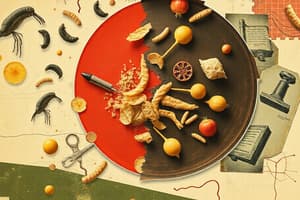Podcast
Questions and Answers
What term is often used to refer to microorganisms?
What term is often used to refer to microorganisms?
- Fungi
- Viruses
- Bacteria
- Microbes (correct)
In food spoilage, what microscopic organisms are responsible for causing changes in food?
In food spoilage, what microscopic organisms are responsible for causing changes in food?
- Worms
- Mites
- Algae
- Bacteria, yeasts, and molds (correct)
Which harmful bacteria can produce deadly toxins under certain conditions?
Which harmful bacteria can produce deadly toxins under certain conditions?
- Lactobacillus
- Clostridium botulinum (correct)
- Leuconostoc
- _Escherichia coli_
How do soil microbes contribute to plant growth and crop yield?
How do soil microbes contribute to plant growth and crop yield?
What historical function have lactic acid bacteria (Lactobacillus spp., Leuconostoc spp.) served?
What historical function have lactic acid bacteria (Lactobacillus spp., Leuconostoc spp.) served?
What are some examples of probiotic microbes that aid digestion and boost immune system function?
What are some examples of probiotic microbes that aid digestion and boost immune system function?
Which microorganism is responsible for causing tuberculosis?
Which microorganism is responsible for causing tuberculosis?
What harmful effects can nitrifying bacteria have on the environment?
What harmful effects can nitrifying bacteria have on the environment?
Which microorganism is associated with causing malaria?
Which microorganism is associated with causing malaria?
How do cyanobacterial blooms in bodies of water impact the environment?
How do cyanobacterial blooms in bodies of water impact the environment?
Flashcards are hidden until you start studying
Study Notes
Exploring Microorganisms
Microorganisms, often referred to as microbes, are minute living entities too small to be seen without magnification. They play pivotal roles across various ecological systems, including our everyday life. Let's delve into their impactful spheres of influence—food spoilage, health benefits, and negative consequences.
Food Spoilage
Food spoilage is one of the most familiar aspects of microbe behavior. As early as 800 BCE, Hippocrates recognized that rotting fruits were caused by worms invisible to naked eyes. Nowadays, we know that it's actually microscopic organisms such as bacteria, yeasts, and molds that trigger these changes. For instance, Clostridium botulinum can produce deadly toxins under certain conditions, leading to botulism if ingested with contaminated foods like canned vegetables and home-canned fish. On the other hand, fermentations initiated by lactic acid bacteria (Lactobacillus spp., Leuconostoc spp.) have been used throughout history to preserve milk, meat, and vegetables in cultures worldwide.
Beneficial Effects
These tiny creatures also powerfully contribute towards improving human welfare and wellbeing through numerous means. For example, soil microbes play critical roles in nutrient cycling, contributing significantly to plant growth and resulting crop yield improvements. Additionally, some probiotic microbes aid digestion and boost immune system function when consumed in appropriate amounts; examples include species from genera like Bifidobacteria, Lactobacillus, and Saccharomyces. Furthermore, scientists synthesize valuable products using specific microbes, such as antibiotics like penicillin derived from Penicillium chrysogenum. Additionally, diverse biofuels like ethanol and biogas result from breakdown processes powered by metabolically active microorganisms.
Diseases
Unfortunately, everything in nature has its downside, and this holds true even for microorganisms. Pathogenic microbes cause debilitating diseases like tuberculosis due to mycobacteria (e.g., Mycobacterium tuberculosis) and tetanus because of bacteria found mainly on wounds (e.g., Clostridium tetani). In addition, many parasitic protozoans, like Plasmodium falciparum causing malaria, fall within this category. To combat such threats, medical researchers study host–pathogen interactions to develop drugs and vaccines against infectious agents, while public health agencies strive to prevent disease outbreaks via sanitation measures and safe food handling practices.
Harmful Effects
Apart from directly harming humans, some microorganisms indirectly endanger us through air pollution, water contamination, and environmental degradation. Nitrifying bacteria convert ammonia into nitrogen oxides (greenhouse gases) under aerobic conditions during sewage treatment, worsening pollution levels. Likewise, cyanobacterial blooms in bodies of water release potent neurotoxins detrimental to aquatic ecosystems and potentially threaten those consuming affected seafood. Moreover, excessive agricultural fertilization may fuel unwanted bacterial proliferation, culminating in groundwater contamination events.
In conclusion, despite their sometimes sinister and devastating impacts, microorganisms serve vital functions in maintaining healthy ecosystems, fostering economic development, and supporting human wellness. We must appreciate their complexity and work responsibly with them if we wish to reap the benefits they offer while minimizing their potential dangers.
Studying That Suits You
Use AI to generate personalized quizzes and flashcards to suit your learning preferences.




